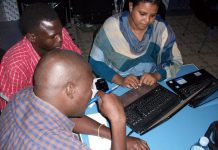
Media organisations need to ensure that the content they produce is available on every device the audience turns to for information.
In previous articles we have looked at the importance of Knowing your audience and Establishing a market differential for that audience which would inform the public debate with original, in-depth journalism.
In the past, broadcasting and publishing were fairly predictable. The audience watched TV, listened to the radio, and bought newspapers.
We worked to deadlines set by the broadcast schedules or the print runs.
The design of devices such as TV and radio changed from time to time, but the basic philosophy of broadcasting bulletins and related programmes changed very little. The same was true with newspapers.
Digital disruption
Then digital journalism disrupted the model. Content could be viewed online, on mobile and on tablets at any time of the day, on demand and on the move. Rolling, 24-hour news channels also contributed to the disruption.
When a group of us launched BBC News Online we realised as we published the first story that life would never be the same again.
We had started the continuous news cycle for the BBC. Everything had to change, including workflows, how stories were created and developed, roles and responsibilities, job descriptions, and organisational structures.
And then social media grew, and the audience became creators and curator of content, producing, commenting, sharing, adding value, beginning conversations, offering options, and participating in the news cycle. Another powerful and disrupting influence.
While all this was taking place, technology was not only matching the ambitions and aspirations of the content producers and content consumers, it was also creating new ways to do both.
Successful media businesses could no longer relax with legacy systems and known ways. They had to innovate, and to innovate they had to understand the audience, the technology, and the market.
So business development managers were hired and units set up to track the changes in audience behaviour in order to try to see what new platforms were being developed and to feed the information back into the news production and business planning departments.
Luckily, for those of us in the news management business, there also developed groups of people who made a living out of analysing the data surrounding changing audience behaviour, examining the implications for content producers and the market, and offering that wisdom to news business at a price.
One of those companies is WeAreSocial in Singapore who produce a six-monthly report on audience behaviour. The data they produce offers valuable and interesting insights into how content is consumed. Much of that data can be viewed, free-of-charge, on their Slideshare site.
Using such information can help media managers plan how their businesses need to evolve. Decision can be taken which are informed by solid business logic.
Digital first, digital parallel or digital denial
Responding to audience behaviour data will probably mean that a media business decides to introduce a digital first strategy.
Digital first means that content is published on digital platforms before, or at the same time, as it’s published on traditional platforms. Please refer to our article From digital denial to digital first.
But a digital first strategy needs to make business sense. There is no point in delivering to digital platforms if they are not being used by your target audience.
And that is why you need to continually monitor how your target audience is accessing news so that you can adapt and change to ensure you are able to meet their information needs in the way they require.
Otherwise you will probably lose that audience, and more aware and alert media organisations that are monitoring changing audience behaviour might take your place.
If it makes sense to adopt a digital first strategy – and it probably will, then the decision will also involve changes in how news is produced and how decisions are made.
You will need to introduce new workflows based around a news ‘superdesk’ acting as a centralised ‘command-and-control’ for the news operation. New roles and responsibilities may have to be introduced – from existing resources. Please refer to our article Convergence: transforming news production.
Central to this will be a planning editor who will take your unique editorial proposition of original in-depth journalism and ensure there is a steady flow of high-quality news and current affairs items designed to meet the information needs of your target audience.
Please refer to the module about forward planning for media organisations. At this stage you will have taken your first steps towards introducing a digital first strategy.
But let’s return to the theme of the first article in this series about setting up a media business.
I likened a media business to a table with four legs. Each leg having to be as sturdy as the other to ensure the table (the media business) doesn’t wobble.
- Leg one is identifying the target audience and its information needs.
- Leg two is establishing a market differential with original, in-depth, issue-led journalism.
- Leg three is adapting to changing audience behaviour and monitoring the market as set out in this article.
- So now let’s move on to leg four, our media organisation’s values. Please refer to the article Winning audience trust and loyalty.








